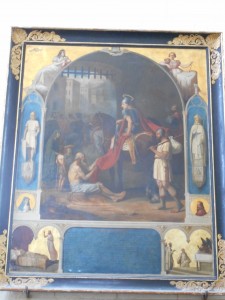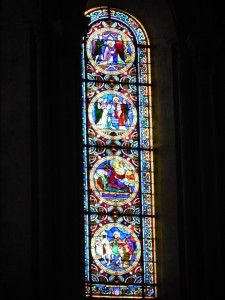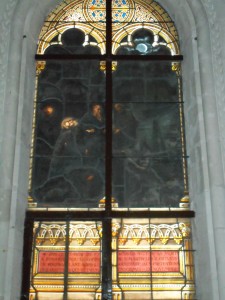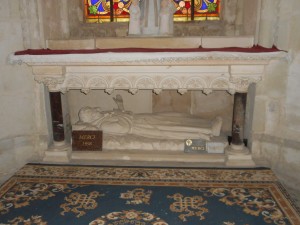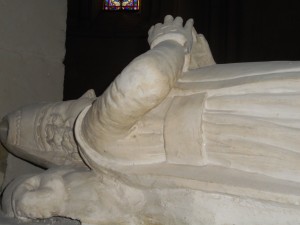L’église de Candes-Saint-Martin fait partie des six églises bâties par saint Martin au IVe siècle, dédiée à saint Maurice. C’est ici qu’est mort saint Martin. L’église est reconstruite aux XIIe et XIIIe siècle, il s’agit l’église actuelle. Cette église appartenait aux possessions Plantagenets. À l’intérieur, on a allié style architectural militaire et style religieux. Elle est l’une des rares églises fortifiée en Touraine. Elle est classée monument historique par la liste de 1840.
La troisième abside renferme la chapelle construite sur l’emplacement de la cellule de saint Martin; par terre, là où se trouvait sa couche, une inscription : « ici est mort saint Martin, le 8 novembre 397 ». La chapelle Saint Martin fut complètement restaurée au XIXe siècle.
L’église possède une peinture représentant la charité de saint Martin sous les portes de la ville d’Amiens, un vitrail de l’enlèvement du corps de saint Martin, des sculptures des saints Innocents.
C’est un tableau d’Antoine RIVOULON peint en 1837. Il a une hauteur de 225 cm, et une largeur de 175 cm. Il fut exposé au Salon de 1837, puis acheté par l’Etat sur la demande du député d’Indre-et-Loire et déposé à la Collégiale la même année. La toile est restaurée en 1997 par Bruno Maudet, Tours.
La scène principale présente saint Martin habillé en chevalier romain, auréolé, sur un cheval sombre, partage son manteau avec un pauvre vieillard, à demi nu et assis sur le sol, à la porte d’Amiens. Cette scène occupe les trois quarts supérieurs de l’œuvre en hauteur comme en largeur. Elle se termine par un cintre dans lequel deux anges, tenant un petit cartouche rectangulaire, portent la date de naissance du saint patron de la paroisse, 316. Deux personnages féminins sont accoudés sur les retombées de l’arc. Sous chacune une niche au fond bleu foncé, celle de gauche contient, la figure d’un soldat, celle de droite, la figure d’un évêque. Sous les deux niches, deux médaillons centrés représentent à gauche la Vierge, à droite le Christ en buste, sur des fonds jaune clair. La partie inférieure du tableau se découpe en trois parties, la partie centrale représente une stèle avec des inscriptions latines sur fond bleu. Cette stèle est entourée de deux petits tableaux, à gauche, Martin, endormi, reçoit la vision du Christ drapé dans la chlamyde qu’il avait donnée au pauvre ; à droite, la scène relate l’anecdote selon laquelle Martin démasque , en présence de quelques frères, un faux martyr.
Dans l’église, le tableau est au dessus de l’inscription qui nous dit « ICI EST MORT SAINT MARTIN LE 8 NOVEMBRE 397 ».
La scène est représenté dans un cercle. On y voit saint Martin nimbé sur un cheval blanc qui coupe sa chlamyde pour en recouvrir un pauvre. Le pauvre, agenouillé, tend la main avec à l’intérieur un récipient pour faire l’aumône. Il est à moitié recouvert par le manteau de saint Martin. En arrière plan, on aperçoit la muraille d’Amiens.
Cette scène est représentée au registre inférieur d’un vitrail à quatre registres. Dans un petit blason en bas du vitrail, on voit une charité en or sur fond bleu.
Réalisé en 1881, il s’agit d’un vitrail représentant l’enlèvement du corps de saint Martin. Cela se passe la nuit, deux moines transportent un corps, celui de saint Martin (nimbé), pendant que deux autres moines dorment. Dans le fond, on distingue le mât d’un bateau. Se trouve sur le mur nord de la chapelle de Saint Martin. De nombreux détails caractérisent ce tableau. Dans le Saint Martin de Lecoy de la Marche est reproduit p. 529 ce vitrail, avec la légende : « Carton de M. Claudius Lavergne fils, pour un vitrail destiné à Candes ». Mais Anne Debal-Morche l’attribue à François Léon Bigot, collaborateur de Louis-Léopold Lobin.
Le rapt du saint par les Tourangeaux se fait à l’encontre des Poitevins selon le récit qu’a laissé Grégoire de Tours. Les tourangeaux récupérèrent le corps de leur évêque et le font sortir par la fenêtre avant e lui faire prendre al direction de Tours par bateau.
« Dès que le saint de Dieu eut commencé à être malade, les gens de Poitiers se réunirent à ceux de Tours pour suivre son convoi. A sa mort, il s’éleva entre les deux peuples une vive altercation (…). Pendant qu’ils se disputaient, le jour fit place à la nuit ; le corps du saint, déposé au milieu de la maison, était gardé par les deux peuples. Les portes ayant été étroitement fermées, les Poitevins voulaient l’enlever par force le lendemain matin ; mais le Dieu tout-puissant ne permit point que la ville de Tours fût privée de son patron. Au milieu de la nuit, toutes les troupes des Poitevins furent accablées de sommeil, et il n’y avait pas un seul homme de cette multitude qui veillât. Les Tourangeaux, les voyant endormis, prirent le corps du saint : les uns le descendirent par la fenêtre, d’autres le reçurent au dehors ; et, l’ayant placé sur un bâtiment, ils naviguèrent avec tout le peuple sur le fleuve de la Vienne. Étant entrés dans le lit de la Loire, ils se dirigèrent vers la ville de Tours en chantant des louanges et des psaumes. Les Poitevins, éveillés par ces chants, et ne retrouvant plus le trésor qu’ils gardaient, s’en retournèrent chez eux couverts de confusion. »
C’est un tombeau surmonté d’un gisant du saint représenté en évêque est abrité dans un enfeu. Ce gisant fait 184×200 cm. Il est placé dans la chapelle nord de la collégiale, où se trouve la dalle annonçant l’emplacement de la mort du saint.
Source MH Mérimée : PA00097608
The church of Candes-Saint-Martin is one of the six churches built by Saint Martin in the 4th century, dedicated to Saint Maurice. It is here that Saint Martin died. The church was rebuilt in the 12th and 13th centuries, and is now the present church. This church belonged to the Plantagenets. The interior combines military and religious architectural styles. It is one of the few fortified churches in Touraine. It is listed as a historical monument in 1840. The third apse contains the chapel built on the site of Saint Martin’s cell; on the floor, where his bed was, there is an inscription: « Here died Saint Martin, on 8 November 397 ». The chapel of Saint Martin was completely restored in the 19th century. The church has a painting representing the charity of Saint Martin under the gates of the city of Amiens, a stained glass window of the removal of the body of Saint Martin, sculptures of the Holy Innocents.
The painting by Antoine RIVOULON painted in 1837. It is 225 cm high and 175 cm wide. It was exhibited at the Salon of 1837, then bought by the State on the request of the deputy of Indre-et-Loire and deposited in the Collegiate Church the same year. The painting was restored in 1997 by Bruno Maudet, Tours. The main scene shows Saint Martin dressed as a Roman knight, haloed, on a dark horse, sharing his cloak with a poor old man, half-naked and sitting on the ground, at the gate of Amiens. This scene occupies the upper three quarters of the work in both height and width. It ends in a bracket in which two angels, holding a small rectangular cartouche, bear the date of birth of the patron saint of the parish, 316. Two female figures are leaning against the arch’s falls. Under each of them is a niche with a dark blue background, the one on the left contains the figure of a soldier, the one on the right, the figure of a bishop. Under the two niches, two medallions in the centre represent the Virgin Mary on the left and Christ in bust form on light yellow backgrounds on the right. The lower part of the painting is divided into three parts, the central part representing a stele with Latin inscriptions on a blue background. This stele is surrounded by two small paintings: on the left, Martin, asleep, receives a vision of Christ draped in the chlamydia he had given to the poor; on the right, the scene relates the anecdote according to which Martin unmasks, in the presence of some brothers, a false martyr. In the church, the painting is above the inscription which reads « HERE DIED SAINT MARTIN ON 8 NOVEMBER 397 ».
The scene is depicted in a circle. Saint Martin, nimbed on a white horse, cuts off his chlamydia to cover a poor man. The poor man, kneeling, holds out his hand with a container inside to give alms. He is half covered by Saint Martin’s cloak. In the background, the wall of Amiens can be seen. This scene is depicted in the lower register of a four-register stained glass window. A small coat of arms at the bottom of the window shows a gold charity on a blue background.
Made in 1881, this is a stained glass window representing the removal of the body of Saint Martin. It takes place at night, two monks are carrying a body, that of Saint Martin (nimbed), while two other monks are sleeping. In the background, the mast of a boat can be seen. It is on the north wall of the chapel of Saint Martin. Many details characterise this painting. In the Saint Martin de Lecoy de la Marche, this stained glass window is reproduced on p. 529, with the caption: « Carton de M. Claudius Lavergne fils, pour un vitrail destiné à Candes ». But Anne Debal-Morche attributes it to François Léon Bigot, a collaborator of Louis-Léopold Lobin. The abduction of the saint by the Tourangeaux was carried out against the Poitevins according to the account left by Gregory of Tours. The Tourangeaux recovered the body of their bishop and took him out of the window before taking him to Tours by boat.
« As soon as the saint of God began to be ill, the people of Poitiers joined those of Tours to follow his convoy. When he died, there arose a sharp altercation between the two peoples (…). While they were arguing, day gave way to night; the body of the saint, laid in the middle of the house, was guarded by both peoples. The doors having been tightly closed, the Poitevins wanted to remove it by force the next morning; but the Almighty God did not allow the city of Tours to be deprived of its patron saint. In the middle of the night, all the troops of the Poitevins were overwhelmed with sleep, and there was not a single man of this multitude who was awake. The Tourangeaux, seeing them asleep, took the body of the saint: some lowered it through the window, others received it outside; and, having placed it on a boat, they sailed with all the people on the river Vienne. Having entered the bed of the Loire, they made their way towards the city of Tours, singing praises and psalms. The Poitevins, awakened by these songs, and no longer finding the treasure they were guarding, returned home in confusion ».
It is a tomb surmounted by a recumbent of the saint represented as a bishop and housed in a coffin. This recumbent is 184×200 cm. It is placed in the north chapel of the collegiate church, where the slab announcing the location of the saint’s death is located.

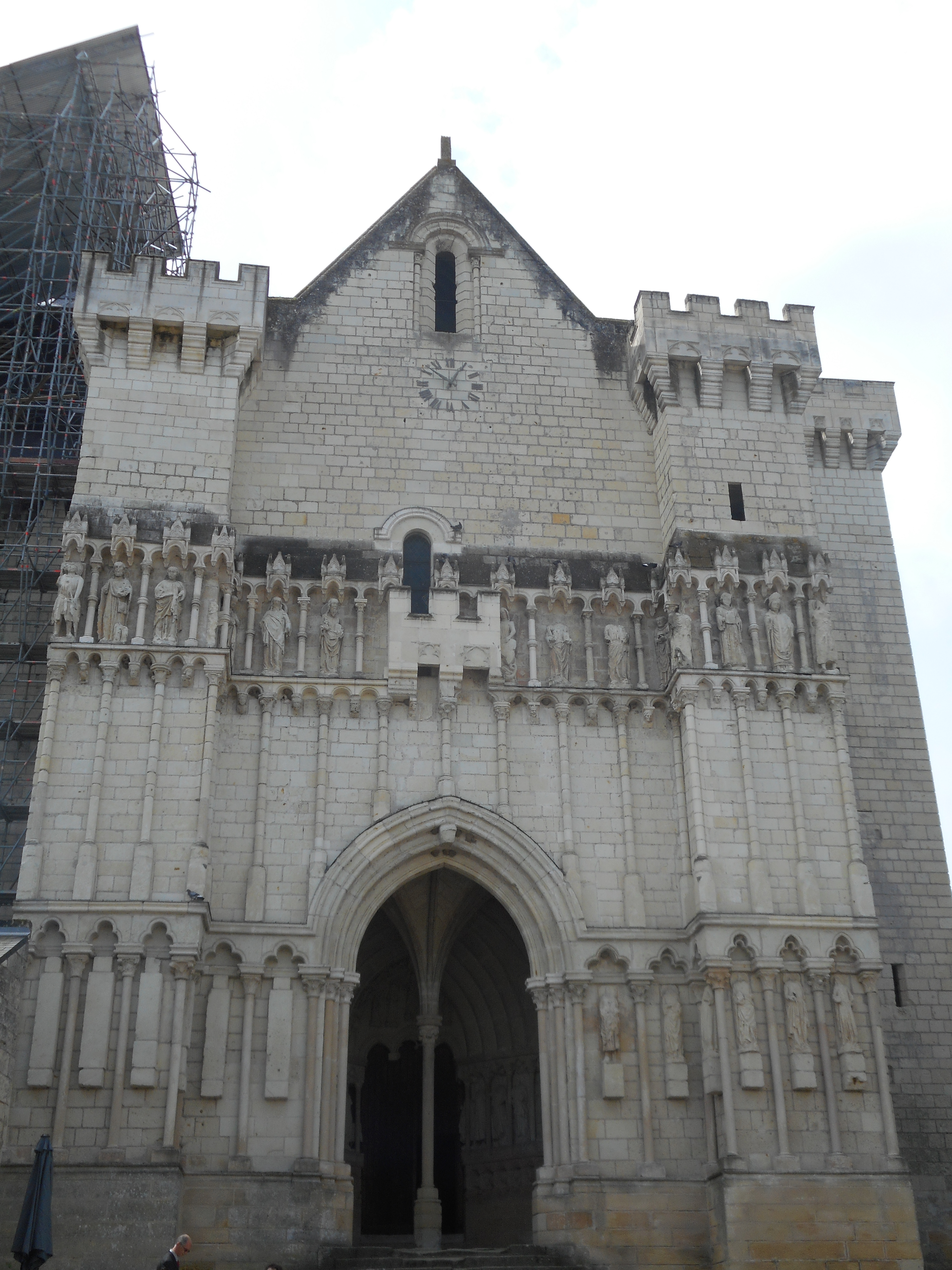 "/>
"/>
